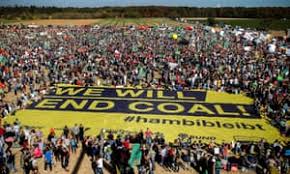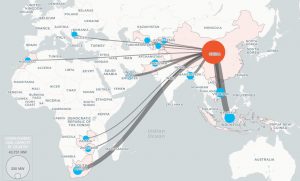The venerable Noam Chomsky on our climate crisis and Nicholas Rees on the startling impacts of air pollution on babies and toddler brain development. But first, we must prevent mass climate suicide by coal, with famous German environmentalist Heffa Schuecking.
Listen to or download this Radio Ecoshock show in CD Quality (57 MB) or Lo-Fi (14 MB)
HEFFA SCHUECKING AND THE MAD COAL RUSH
Do you think coal power is disappearing – being replaced by cleaner natural gas and renewable energy? Think again. According to data released by the International Energy Agency in 2018, coal consumption is going back up after two years of decline. That is terrible news for our future climate.
Most of that new demand is coming from Asia. Japan and South Korea are pumping billions into new coal plant construction. Despite the good news you’ve heard about massive renewables in China, Chinese banks are investing tens of billions of dollars to expand coal power in many parts of the world. Wall Street is funding even more.
Here to give us the big picture is Heffa Schuecking. Heffa is a long-standing environmental leader in Germany, and a winner of the Goldman Environmental Prize. She is Managing Director of the German non-profit group Urgewald, which maintains a database of all coal projects and investors world-wide.
Listen to or download this Radio Ecoshock 30 minute interview with Heffa Schueking in CD Quality or Lo-Fi
GERMANY – STILL COAL POWERED!
From the outside, we hear a lot about solar power and Danish wind sweeping into the German electricity system. But at least 35% of German power still comes from coal.
In October 2018, about 50,000 protesters showed up to fight off the energy company RWE. That company wants to clear-cut more ancient Hambach Forest in Germany for a giant open-pit coal mine.

Coal protest Hambach Forest Germany 2018
WE ARE STILL BUILDING COAL PLANTS AROUND THE WORLD
To prevent horrible climate change, we need to get out of coal power. But according to the group CoalEXit, since the Paris Climate Agreement of 2015, the number of coal power plants in the world has continued to grow. They say new coal plants starting up in the last three years use as much coal as “all of Japan’s and Russia’s coal plants put together (CoalSwarm).”
THE CHINA COAL DRAGON
No country has installed more solar power, or more mass transit, than China. They are world leaders in alternative tech. But what is the situation with coal power in China now? Officially, the Chinese government has recognized climate change as a serious threat. Unlike the United States and other countries in retreat or denial, China speaks as a world leader on climate change. So it was shocking to learn from Heffa’s group Urgewald that China is financing massive amounts of coal power expansion all over the world.

Chinese coal expansion (courtesy of CoalSwarm)
A Radio Ecoshock listener wrote to complain about Chinese banks putting up the money for another coal power plant in Serbia.
In May 2017, the Global Environmental Institute, based in Beijing, reported that Chinese companies and banks are involved in 240 coal-fired power projects in 25 of the 65 countries along their “Belt and Road” project. Fifty four were already under construction by 2016. To find out more about the “Belt and Road” project (and you should!!) please check out this article “How China’s Big Overseas Initiative Threatens Global Climate Progress” by Yale 360.
Isabel Hilton writes:
“Just building the land-based Silk Road Economic Belt and the 21st Century Maritime Silk Road will absorb massive amounts of concrete, steel, and chemicals, creating new power stations, mines, roads, railways, airports, and container ports, many in countries with poor environmental oversight. But more worrying still is the vision of industrial development to follow, and the energy that is planned to fuel it. While China has imposed a cap on coal consumption at home, its coal and energy companies are on a building spree overseas.”
“Chinese companies are involved in at least 240 coal projects in 25 of the Belt and Road countries, including in Bangladesh, Pakistan, Serbia, Kenya, Ghana, Malawi, and Zimbabwe. China is also financing about half of proposed new coal capacity in Egypt, Tanzania, and Zambia. ”
Here is another helpful article about Chinese coal plant exports, from CNBC news.
In early October, Bloomberg news wrote a feature expose on China’s funding for climate-damaging coal expansion. It was based on reporting from Heffa’s group Urgewald.
The United States reduced their fossil fuel emissions partly by exporting their dirtiest industries to Asia, mainly to China. Now the Chinese government is facing serious public pressure to clean up polluted air. I wonder if their plan is to export the dirtiest industries to other Asian countries in the Belt and Road orbit.
THE OTHER DIRTY PROFITS FROM EXPANDING COAL
But let us not just make Chinese companies and banks the boogey-man. Only one third of proposed new coal plants are financed or built by Chinese interests. The other two thirds comes from other nationalities. For example, Japanese companies and banks are pushing coal plants. So is the biggest source of capital on the planet: Wall Street. Through large investment houses, your own pension fund or mutual fund may be investing in wrecking the planet with more coal plants. Short term profit rules over ecological survival!
Many companies that sell coal plants in Africa, Eastern Europe, and the rest of the world are hard to track. They may have names that suggest they really sell alternative or green energy. There are corporate shells hiding the real investors. That is why Urgewald created a massive database which names names. You or your investment manager can check for dirty companies using that database.
Another tool is to insist that insurance companies get out of coal. We tend to forget that insurance companies hold and invest trillions of dollars/euros/pounds or yen. Urgewald has great success in getting three of Europe’s (and the world’s) largest insurance companies to name their coal exit date. Germany’s giant Allianz insurance has promised to stop insuring coal companies, and to withdraw investments from any projects or companies dealing in coal in a structured way over the next couple of decades. The Italian insurer Assicurazioni Generali has also promised to cut out coal.
MORE COAL COUNTRY ROUND UP
Here are some of the key country facts Heffa tells us in this interview:
Heffa says that 53% of Europe’s emissions come from coal plants in Germany and Poland. Closing these coal plants is key to Europe meeting their climate targets.
The coal “pipeline” (new production planned or coming online) was over 1,200,000 megawatts. “The first time when we did this research, we were really, really frightened. By last year, that pipeline shrunk to 840,000 megawatts, and now the pipeline is at 670,000 megawatts. That is better news, but even if this reduced number is actually built, that would increase global coal plant emissions by 33%!”
CHINA
China still has plans for over 250,000 megawatts of new coal power. That is about 1/3 of coal power in the pipeline globally. Some years ago the Chinese government set a cap for coal power at 1,100,000 megawatts. They are currently at 990,000 megawatts. So if they complete the planned coal power, they will sail past their previously stated maximum. “Every year over 360,000 people in China die prematurely due to just pollution from the coal industry.” So there is a big public push-back to clean up the air. Even the highest members of the Communist Party must breath the polluted air. But of course some provinces still see coal as key to their development, and companies want to keep coal construction going.
SERBIA
“Seventy five percent of Serbia’s electricity production is coal-fired, mainly by lignite.” Serbia is already over European Union limits for pollution, but they still plan to build two more coal power plants. it is a partnership between the Serbian national utility and the China Machinery Engineering Corporation. Chinese banks have offered to pay for the construction.
INDIA
Over 100,000 megawatts of new coal power is still planned in India. However, over the past year 24,000 megawatts of planned new coal power was scrapped. India has discovered that alternative energy, especially solar, is cheaper, and does not require such a massive power grid to deliver it. The price of renewable energy in India dropped by 50% over the past two years. Solar is now cheaper to produce than coal, in fact 20% cheaper than even using existing coal fired generation.
EGYPT
Egypt is the saddest case, showing how this civilization is still heading in the wrong direction, constructing mass suicide by coal. Until 2015, Egypt had a law prohibiting the construction of mining coal, importing it, or using it for generating electricity. The country has no coal resources. But with a change of regime, and likely some bribe money, Egypt is now planning on joining the 19th century by building new coal plants! They will have to import all the coal of course. This commits Egypt to burning coal for up to 60 years, the life of the average coal generating plant. All that comes in the country with the largest solar resources in the world. The strong sun is almost always shining in Egypt, but that opportunity to avoid the coal crunch is being missed.
NOAM CHOMSKY
My thanks to Stuart Scott from scientistswarning.org for this conversation with 90-year-old Noam Chomsky. You can watch that interview on Youtube below. It is titled “Political Betrayal [turning into], Mobilizing Action” and recorded Dec 6, 2018.
Here is one great thing about Noam Chomsky, who turned 90 in December. From his decades of writing and research on all kinds of topics, from wars to injustice, Dr. Chomsky now says climate change is the greatest threat to human existence. This is the issue we solve or fail completely.
You can listen to or download the radio version of this interview (16 minutes) in CD Quality or Lo-Fi
NICHOLAS REES – SMOG RISK TO INFANT DEVELOPMENT
We just have time for part of my conversation with Nicholas Rees from UNICEF. “Danger in the Air: How air pollution can affect brain development in young children“. That is from UNICEF, the United Nations International Children’s Emergency Fund. We have Nicholas Rees on the line, the Policy Advocacy Specialist who wrote the report.

Nicholas Rees UNICEF
This report from UNICEF came out at the end of 2017. But the public still doesn’t know our exhaust pipe gas can hurt babies’ brains in ways that could damage them for life. I see science news detailing the impacts of air pollution on everybody from young athletes to seniors. According to CNN, who cites WHO data, 38,000 Americans die each year from air pollution.
You can listen to or download the this 15 minute interview with Nicholas Rees of UNICEF in CD Quality or Lo-Fi
THREE WAYS POLLUTION GETS INTO OUR BRAINS
It may be disheartening, but let’s dive into the three ways smog is getting to the brain formation of children. The first is something called “neuro-inflammation”. The second route for smog to get to the brain really intrigued me. Pollution can reach our brains directly through our nose.
The third pollutant in smog I know well. In the early 1990’s I researched polycyclic aromatic hydrocarbons, or PAHs. Fossil fuel combustion produces PAHs, and so do forest fires. I recall an article explaining the closer you live to a busy street or highway, the more PAHs and other pollution you get. A lot of us live on busy streets, and a lot of us are getting a high daily dose of PAHs.
A published study concludes, quote: “Our findings suggest that prenatal exposure to PAH air pollutants contributes to slower processing speed, attention-deficit/hyperactivity disorder symptoms, and externalizing problems in urban youth“. Those are the kids who will have to cope with a damaged climate at the same time.
Then we have another new study, published in August 2018, this one by Chinese academics. The title is “The impact of exposure to air pollution on cognitive performance“. As Kevin Loria wrote for the World Economic Forum, this study found, quote “chronic exposure to air pollution appears to cause detrimental effects on cognition that get worse throughout life, potentially increasing risk factors for degenerative diseases like dementia and Alzheimer’s.” A few historians suggest the Romans became less intelligent due to lead they ingested from lead plates and goblets. Could we experience the same from air pollution?
Is it fair to compare fossil-powered air pollution to smoking cigarettes? Both industries tried to smother public interest in these health threats. A key difference for me, and this comes out in your UNICEF report “Danger in the Air: How air pollution can affect brain development in young children”: an adult can decide to become more healthy and quit smoking. After a year or so, our bodies build new lungs. But if brains do not develop fully in babies, that can’t happen later, and babies are not able to make a choice. We have to defend babies! Any of us might develop serious and life-threatening illness, and never realize it began in the womb, or when we were babies, inhaling exhaust fumes.
Once again, we are all out of time! If you can help support continuing Radio Ecoshock, find out how here. Please tune in again next week, for more Radio Ecoshock.
But coal produces the aerosols and particulates which contribute to global dimming. Lose this aerosol masking effect and global average temperature will increase by more than 1C, according to James Hansen.
Yes, but that is no reason to continue with coal burning. Humanity should work on reducing GHG emissions from all sources and protect the carbon sinks, like forests, instead of relying on fine particulates to postpone the amount of warming in the pipeline.